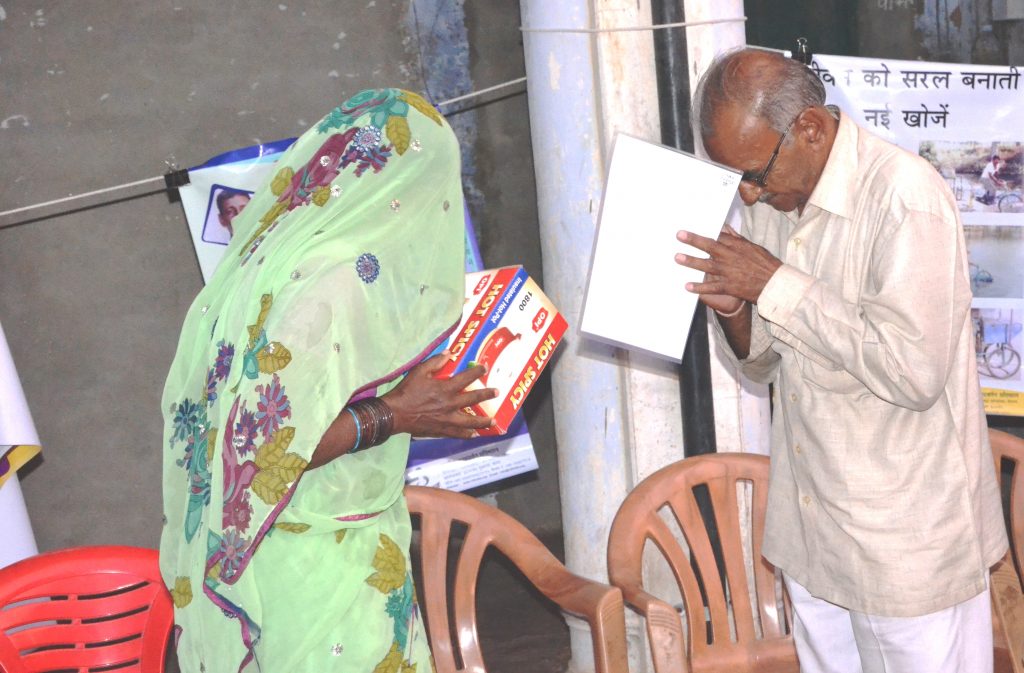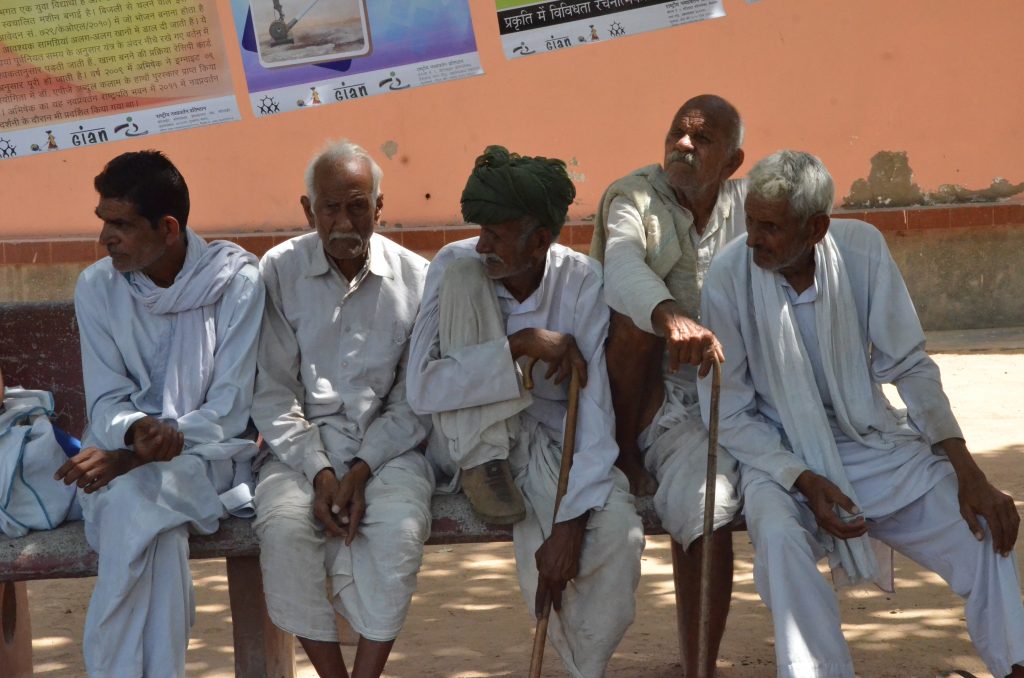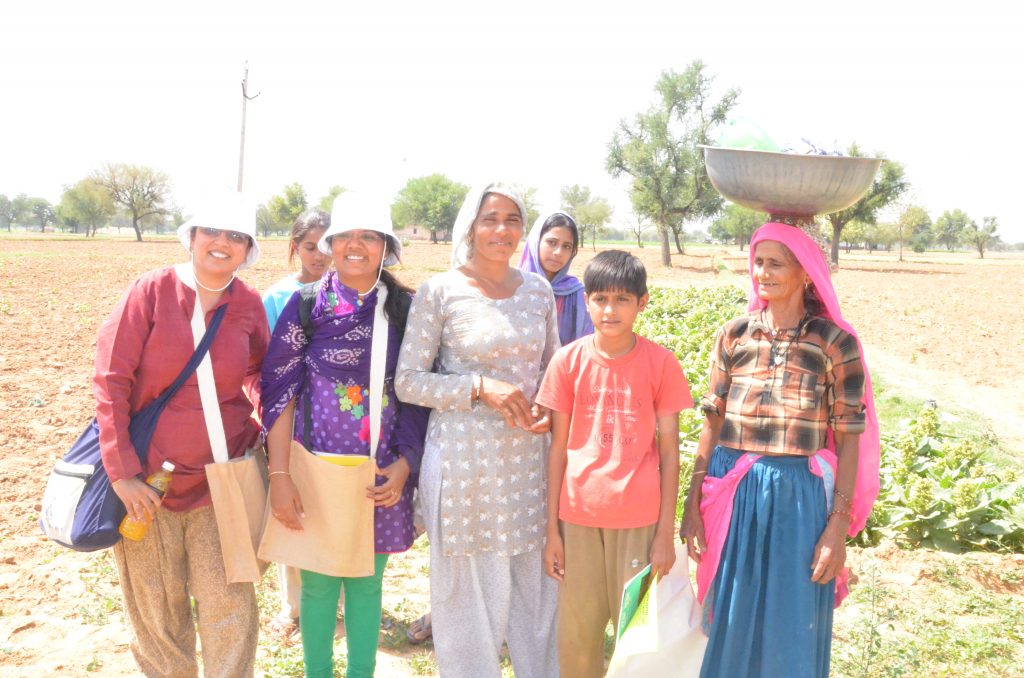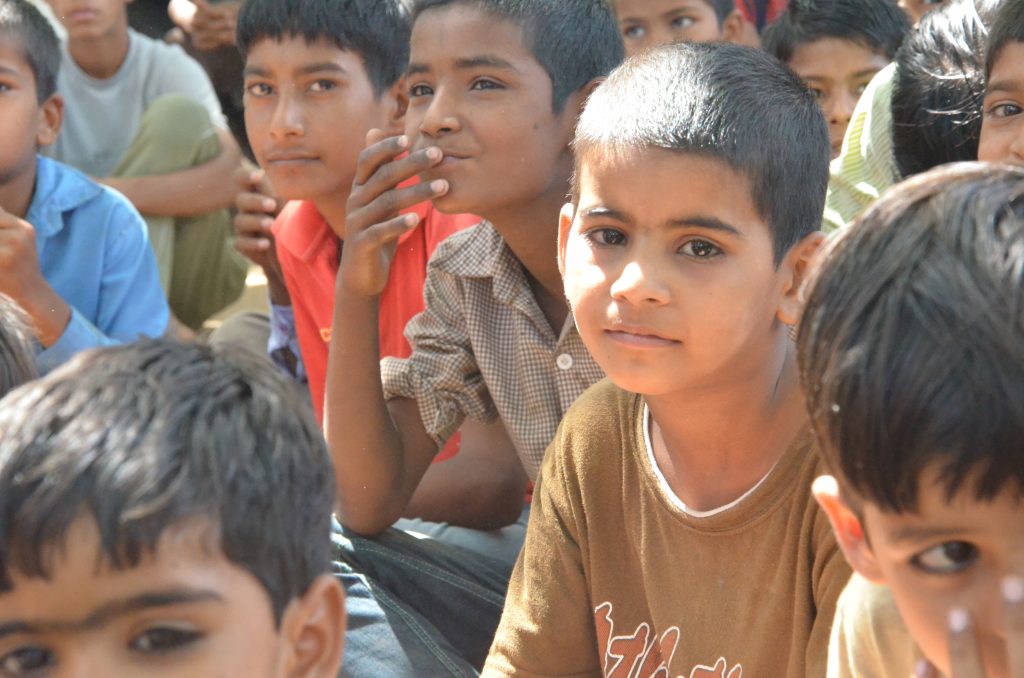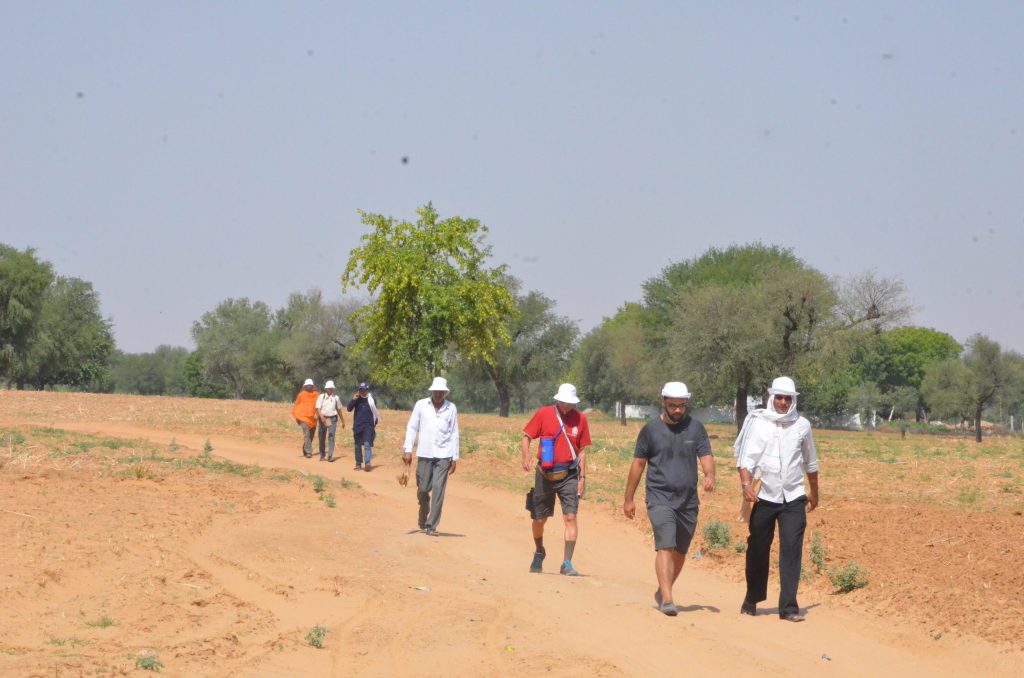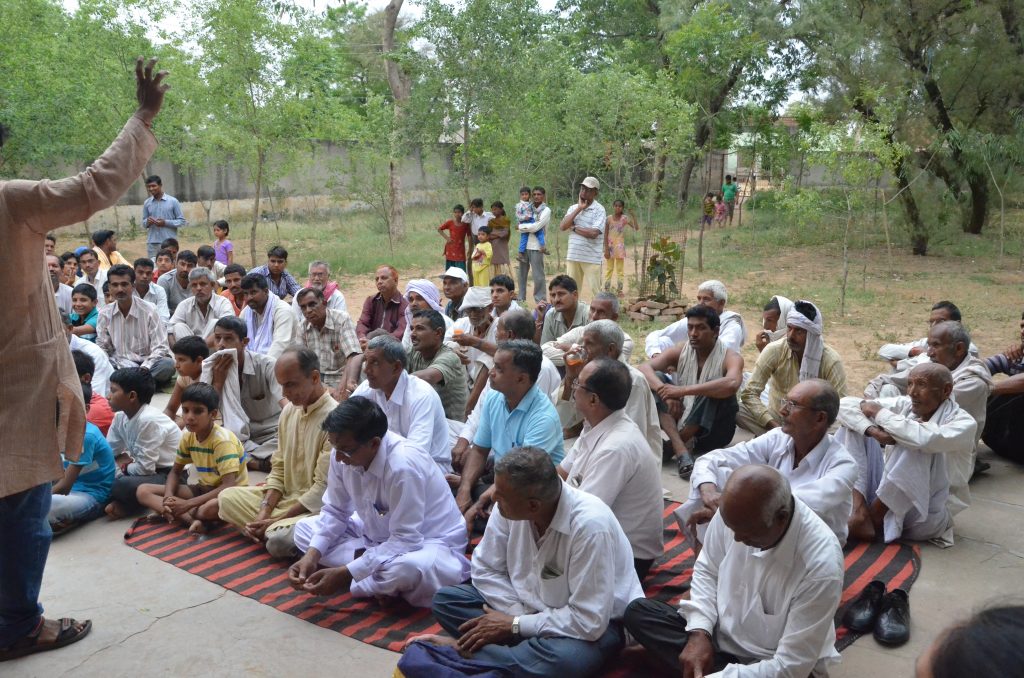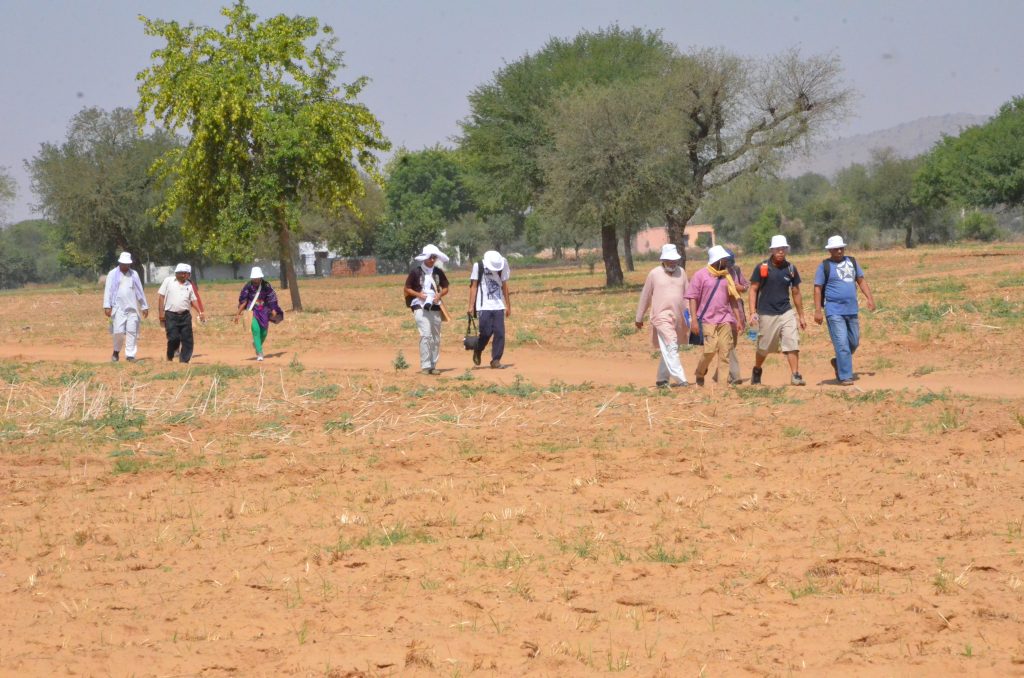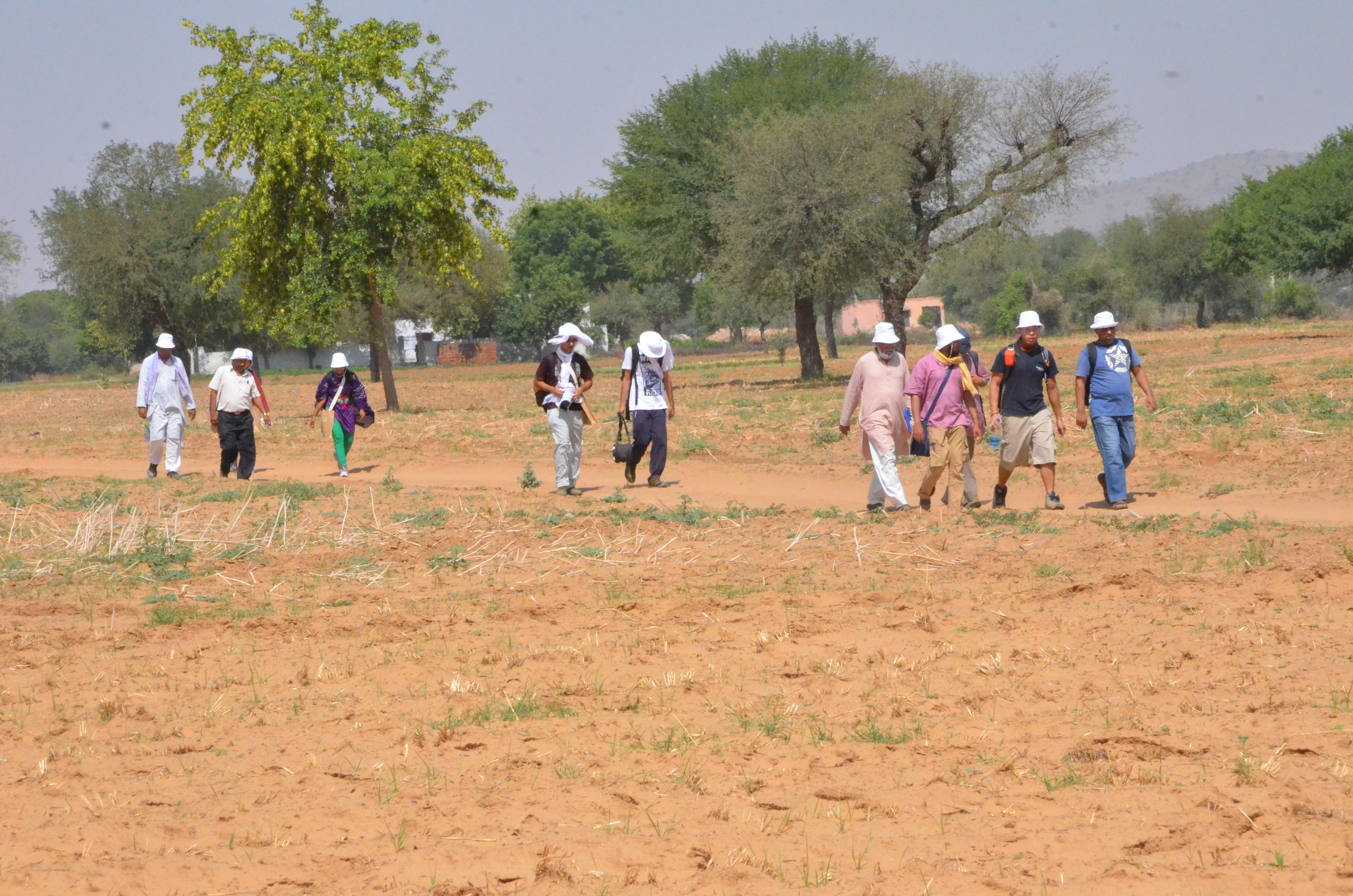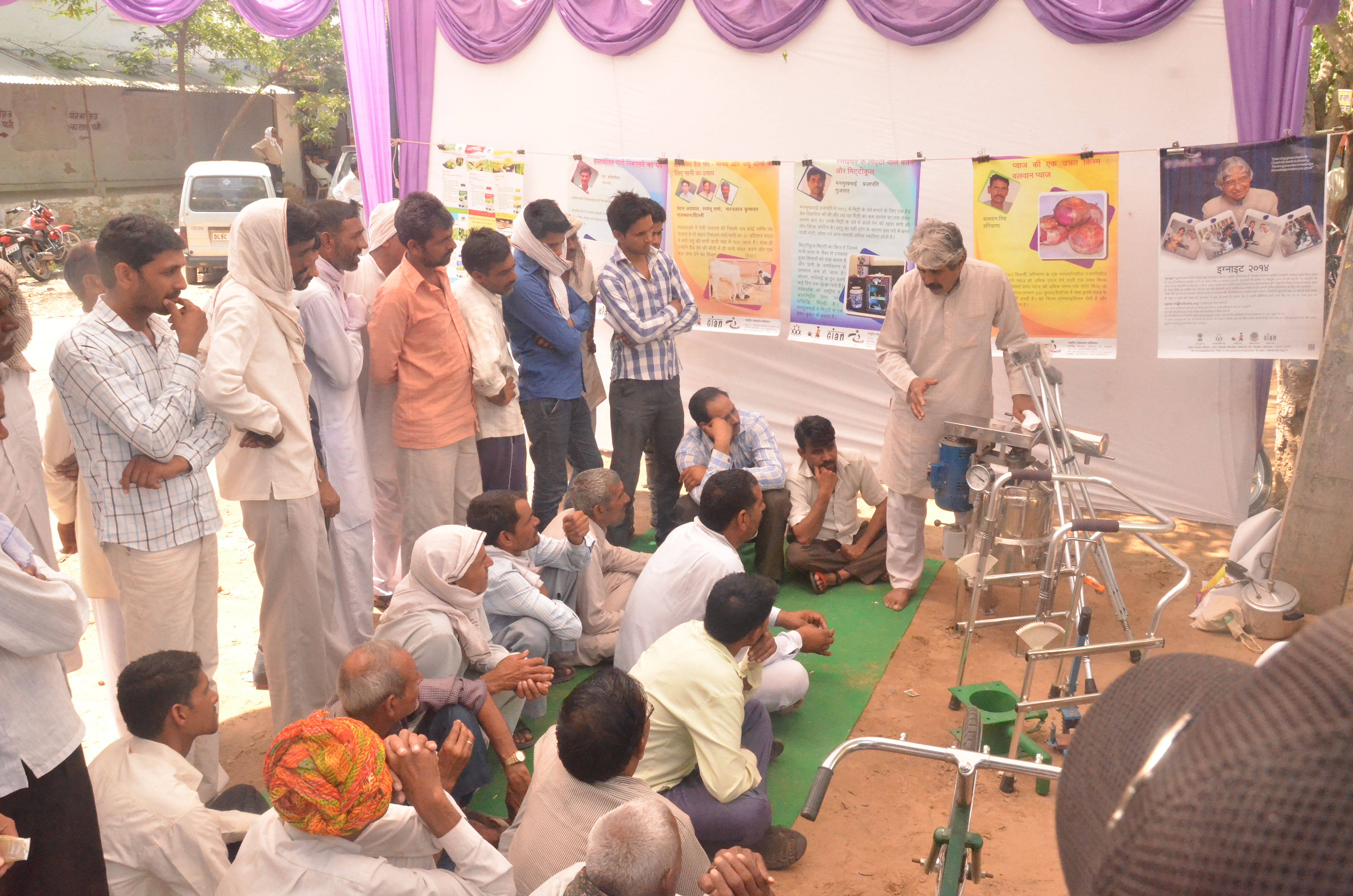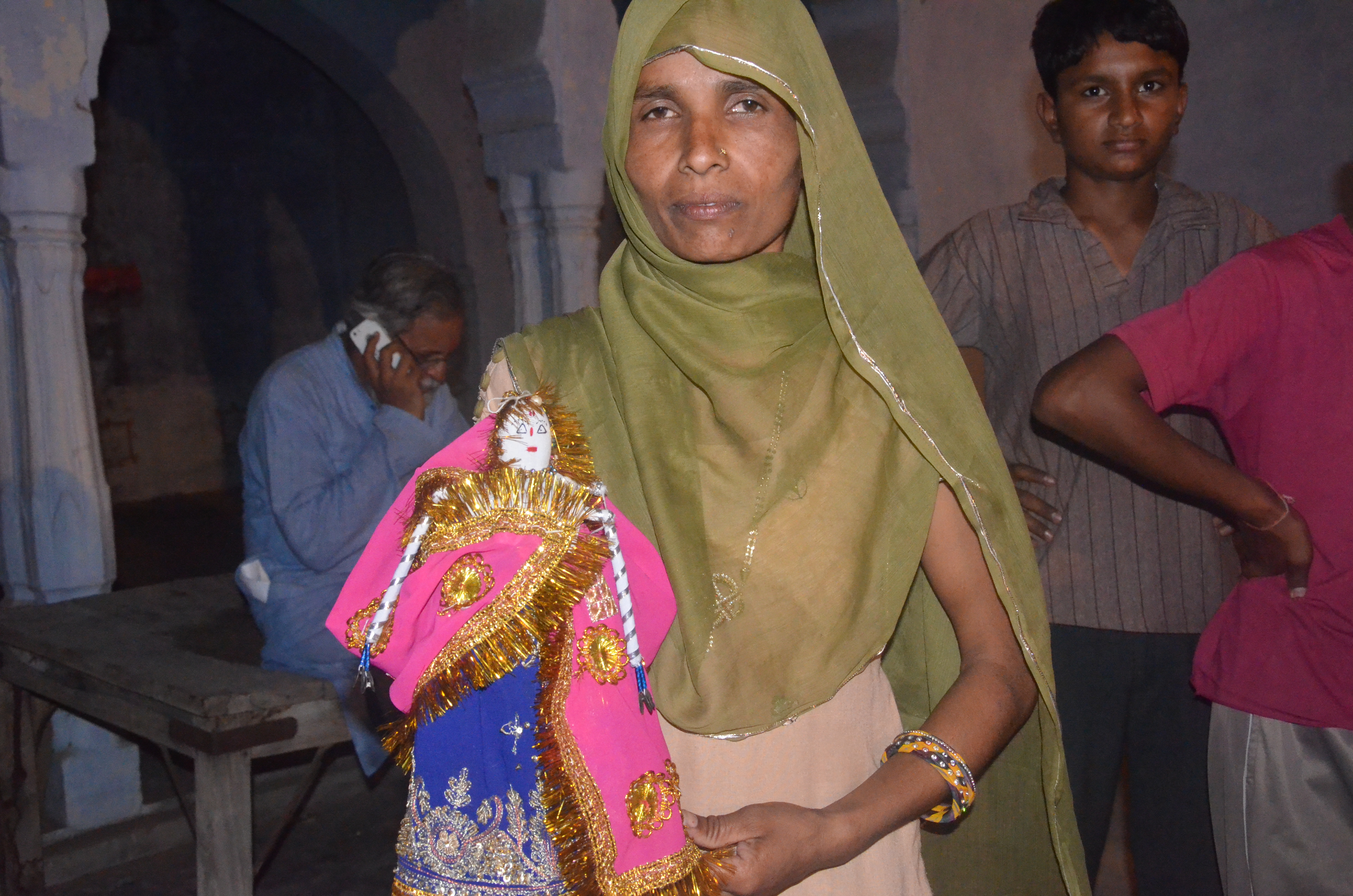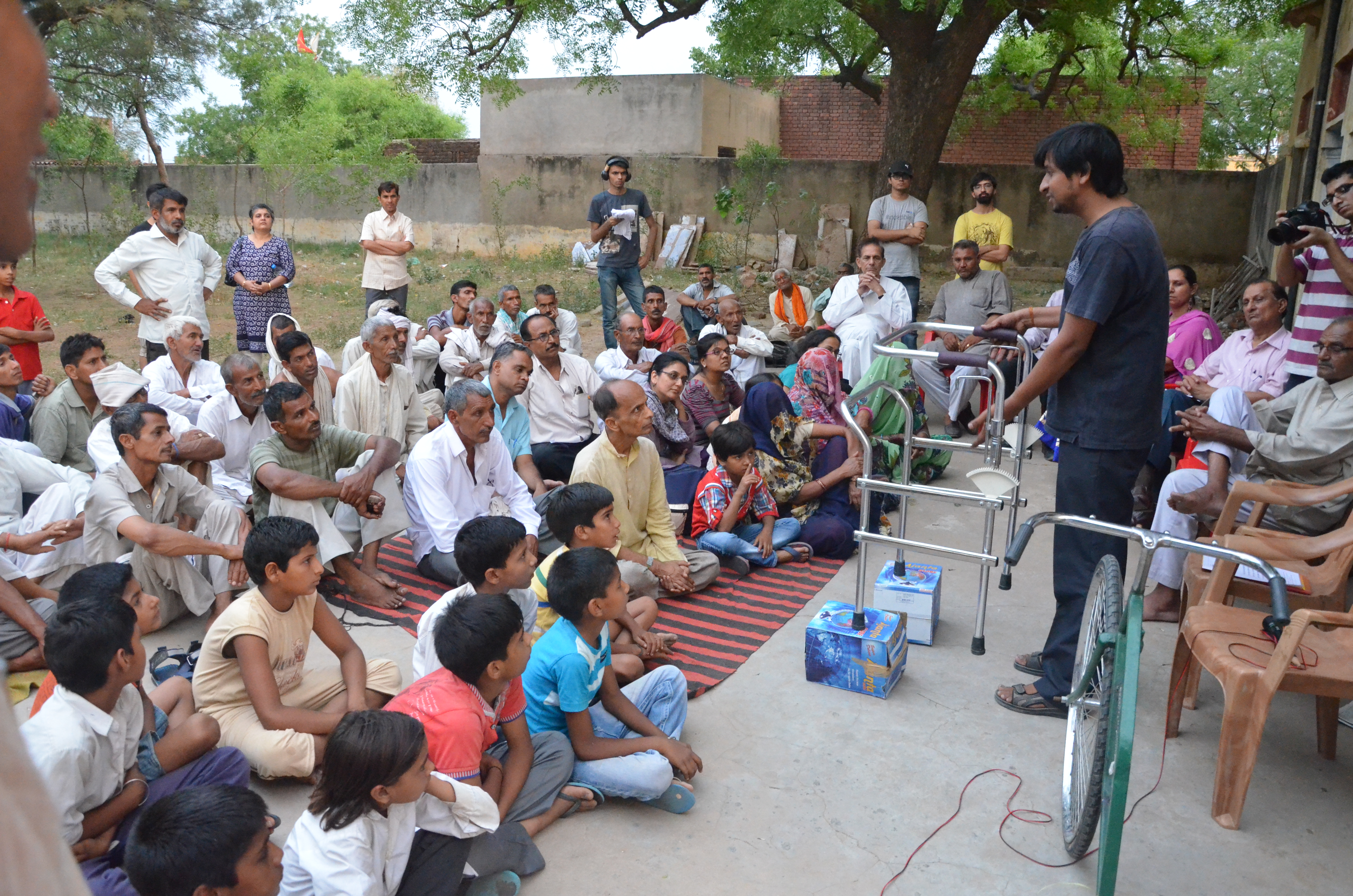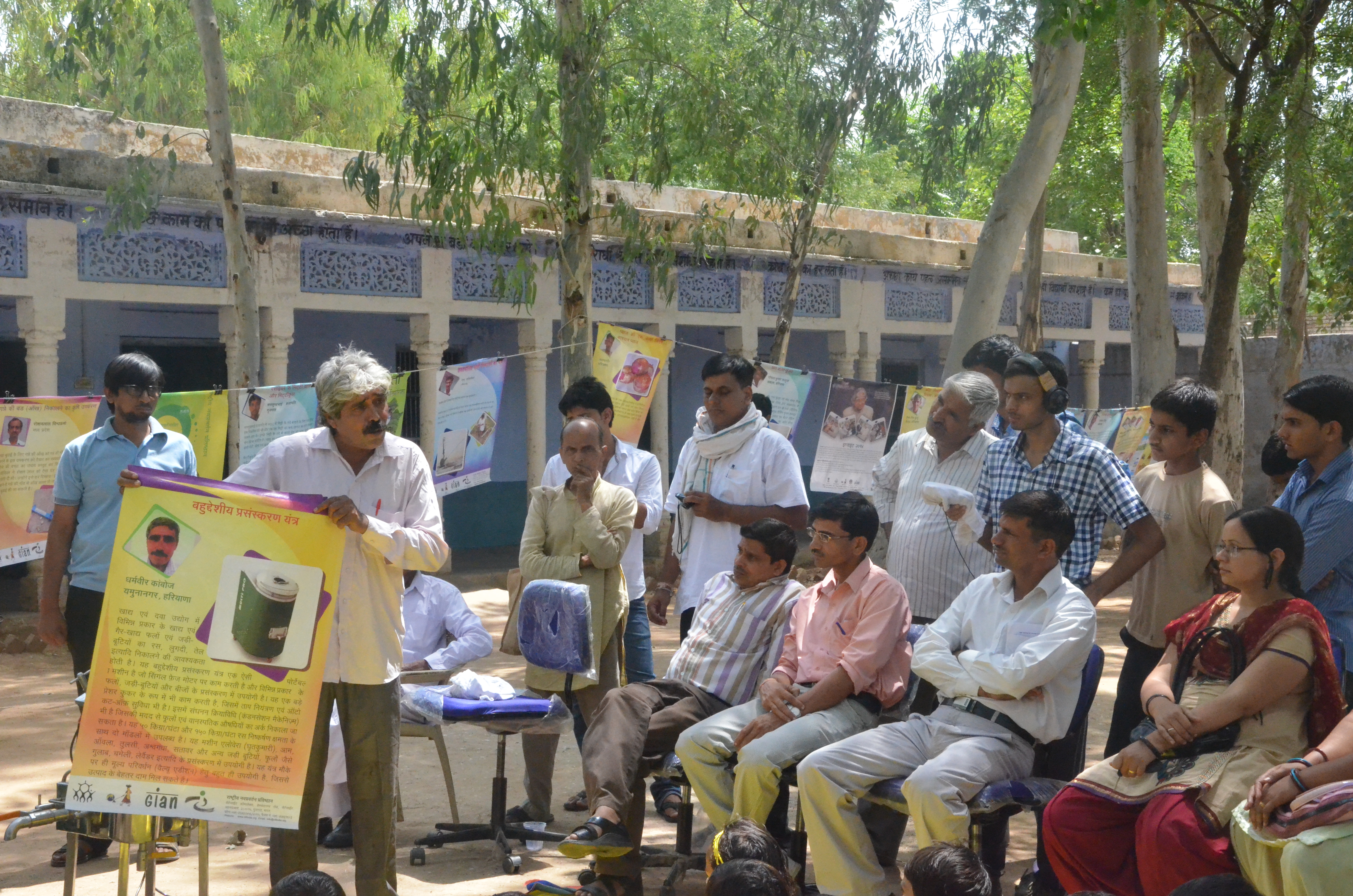Get Next Shodhyatra Update:
Phone:
079-27913293, 27912792
Email:
shodhyatra@sristi.org
33RD SHODHYATRA, HARYANA
24th May to 31st May, 2014
COURAGE, CREATIVITY AND COMPASSION
A conventionally drought prone region on the border of Haryana and Rajasthan where I pursued my doctoral research way back in late 70s taught us lessons in fortitude, fellowship and sustaining a feisty spirit. Never before did we come across so many memorials to the soldiers who had sacrificed their lives for the nation. If there is one place which knows how to be grateful and appreciative of the sacrifice of the young people for their motherland, this is the region. An obvious question which arises then in any curious mind is: Where does this courage come from? We were deeply inspired by another unique custom of the region where we didn’t observe a single malnourished child. The mothers breast-feed their infants up to 2 – 2.5 years and if the second child is not born soon enough, then even till five years. May be there is a connection between these two observations.
he culture of the region has emerged through an autonomous blend of traditions evolved in both Rajasthan and Haryana. One of the reasons for the fortitudinous spirit perhaps was the historical neglect this region received during the years when it was a part of a combined Pepsu [Patiala and east Punjab state union] state. At that time, Himachal, Haryana and Punjab were part of common state.
Mahendragargh district was considered kala pani of the region. Whenever any officer had to be punished, this region was used as punishment posting. Naturally, we don’t just punish the officer or staff, but more importantly punish the people. Many areas which had big sand dunes have been completely transformed over the last four decades with the advent of sprinkler irrigation. Undoubtedly, the water table has gone down. Use of practically free electricity and sprinkler continously (even when these are not needed) has added to that problem. In the context of cultural traditions, we came across many outstanding old havelis and resting places [chhatris] either engraved in wood or painted in colour to add tremendous richness to the aesthetic landscape. Many of these old havelis were built by the baniya trading community, most of whom have left the villages. They would often visit their villages once in a year to celebrate certain festivals. Through such a landscape, we were reminded of a very warm hospitable culture which I had first experienced in the 70s. Another striking feature of the region was availability of drinking water at short distances so as to quench the thirst of people passing by in the hot summer. We have walked through at least 15 states during summer but at no place did we find so many unmanned watering points. In some of the places, people must have brought water from a long distance since they didn’t seem to be any source nearby. Memoryscapes emerge when commonly shared landscapes are endowed with memories of diverse cultures. For me, then a young researcher in the late seventies, it was a land of understanding contrasts of life. Why are people so hospitable to a stranger who can hardly reciprocate their kindness at all, may be ever? Why do people smile so often when the region suffers so many droughts and indifference from the state? I could now see that the spirit to sustain respect for elders without curbing youthful aspirations has only grown in the intervening years.
The Walk begins The Shodhyatra began from Central University campus where the faculty and the students gave us a very warm reception. In the village of Jantpali, farmers shared their problems of the menace of blue bull which damaged their crops. Shodhyatris gave a small boooklet of practices excerpted from The Honey Bee Network database for the purpose based on the experiences of other creative communities around India. A biodiversity and recipe competition was organized among the children. We were joined by Hiralal Yadav at the university who walked with us to Bhawana village. He had been cycling all around the benches with adjustable height so that children can sit in comfort. Anjali suggested bucket with wheels and also a bag which could convert into a seat. In the biodiversity competition, 41 plants were reported with their uses by the winner among 36 kids who participated. Mangala Ram shared his knowledge about plants and their uses. Manju Devi brought raita made of hogweed leaves. She claimed that it helped in curing the anemia.
On the way to Talvana, some of the farmers accompanied us and showed us various fields. Kedarnath had practised organic agriculture for the last few years. Decanted water after soaking limestone in it was sprayed on the cotton crop to control the pests. The interactions with the farmers revealed that not many of them had really heard about Kedarnath’s experiences. After passing through Khedi village, we reached Agiar. Sudhir showed a mechanism on a two wheeler, which, if the stand is not lifted, the vehicle will not start and so avoids accidents. He had actually come from Riwari to showcase his improvement. Anita shared a problem which most of us have faced in our homes. When we have to clean the fans, we have to put a chair on the top of a table to be able to reach the ceiling fan. Even then it is not easy to clean the back side of the blades of fan. Anita suggested that fan should be so designed that one can bring them down when one has to clean them and raise them afterwards. Pawan Nath had listed many plants for their uses for animals, crops and human purposes. He didn’t want to share the list though he wouldn’t mind if we photographed it. On the way to Patheda village, we saw a lot of sprinklers being used even when there didn’t seem to be much need for water in the field. Almost free electricity had led to excessive use of water and of course, decline in the ground water.
Madhav Singh wanted to develop a weeder for cotton. He contacted Parmindar Singh, a local fabricator in Patheda village to design a mechanical solution. On our request, the fabricator brought the newly designed three wheel weeder which many other villagers hadn’t seen till then. This was the first local innovation that got our attention. In Gudha, among various ideas that were contributed by the children, one was about vehicles not starting till the driver puts the seat belt on. Another idea appreciated by the yatris was having a ticket checking sensor at the bus entrance to know who has bought a ticket and who hasn’t. Villagers recited folk songs in the night to help us appreciate the local culture better. We visited a government school in the morning where a lot of interesting ideas were shared. On the way to Chelabas, several people stopped us on the way and asked us about the purpose of about our walk. We saw many memorials for war heroes and also came across bird feeding platforms. Navratna Choudhary had never put chemical pesticides or fertiliser in his field. When he shared the way he made herbal pesticide, we asked the villagers as to whether they had ever used it. They hadn’t because they had not heard about it. And the reason seemed to be that there never was any discussion about it. We recalled how in the Gujarat to Rajasthan shodhyatra more than decade and a half ago, a similar situation had arisen. While talking to a teacher in a school we had asked if he knew about any local solution which actually worked very well. The teacher recalled how he met a person at a bus stand many years earlier. During the conversation he learned that for preventing termite attack, one could put ash of dried leaves of sagwan tree along with dried leaves in the pit while planting tree seedlings. He was trying to grow mango trees and they were dying soon after. He recalled his five year old casual conversation at bus stand. He contacted that old acquaintance, learned the practice, applied and saved his mango trees. But when asked, why had he not shared this with his class ever. He said, “a context for such a conversation never emerged so far till that day”.
Shodhyatris have also to reflect on the absence of such a context for local experiments and knowledge emerging in day to day life. After learning about his practice, many villagers showed interest in trying out his formulations. Jokingly many did say that they considered Navratna as a crazy person. After walking a few kilometres, we came across a house with a large courtyard amd some old ropes hanging on the wall. The look of the wall was like a modern art installation. Out of curiosity, we enetred that house and met two sisters married to two brothers. The quality of milk and other milk product improved when cattle was fed with unopened bolls of BT cotton, said Monika and her sister. This was contrary to the popular perception among many social activists opposing GM crops. Shodhyatris from Gujarat had a smile on their face, as if implying, did we not say that!
In Rambas, yatris met Jagat Singh a well-known herbal healer who is visited daily by 150-200 patients suffering from spinal cord problems. He treats them free of cost. Patients come from other states like Madhya Pradesh, Uttar Pradesh, Rajasthan, Delhi, Punjab, etc. Jagat Singh makes arrangements for their stay and food on his farm free of cost, until the treatment is completed. He is well known in the region for curing patients who could not be treated even by the well-known hospitals, despite patients having gone through various operations.
Why do we miss so many local solution providers all around us in our daily life? Why does our policy making system not draw upon insights of such creative people and communities more than it does at present? When will antipathies against local wisdom, insights and experimental ethics be overpowered in our bureaucracy? We will reflect on these questions in the second part of the shodhyatra report in the next issue, till then we hope to hear from the readers.
In the first part, we experienced a very rich tradition of offering drinking water to strangers on the roadside, memorials to martyrs, encounters with organic farmers and the creative ideas of many children. When we reached Dhana, after walking from Rambas, the community offered us Raabadi. It is a refreshing local drink, which protects people from sunstroke apart from boosting energy instantly. During the demonstration of food processing machine by Dharamveer, the community members did not agree that it could generate so much of revenue as he claimed. Finally, after an intense debate, the elders agreed to send a few young students to be trained by Dhramveer so that they could test the technology in the village.
On the way to Mauhadi, we saw a farmer on a motorbike trying to scare away a herd of bluebull to protect his crop. We gave him a booklet based on alternative practices for the purpose pooled from the Honey Bee Database. After reaching Gomla, a village recipient of the President’s honour for one of the cleanest villages, we gathered in a garden and started an impromptu dialogue with the children about new ideas. Ravikant Sharma, class six, suggested a recorder which gave a printout of the recorded matter in a few minutes. He obviously meant that the printer should have the ability to convert voice into text and then print it, an idea far ahead of where we are today. He also wanted an iron press charged by solar light for ironing the clothes.
On the way back, we met the former Sarpanch of the village who stopped us and explained how he had managed to lay down proper sewerage lines, make pukka roads and develop gardens for children to play in. Yatris noticed while walking to Mohalda that tree density in cultivated fields was much higher than observed so far. This practice was observed first when I was doing my doctoral research in the area forty years ago. Given the high dependence of people on livestock in this region, the lopping from trees provided much needed fodder. The trees also helped as a windbreak, when strong storms lead to soil erosion during the summers. Most of these trees are not planted. The saplings are allowed to survive while ploughing the land with bullocks or camels. Wherever tractorization has taken over, leaving such saplings aside has become almost impossible in such dry regions.
Walking through the fields we came across a trench digger used to lay down the pipes for installing sprinklers. The lady from the house nearby invited us to have buttermilk and take a little rest. We moved on after enjoying the hospitality for strangers like us. On the way, we observed remnants of some old structures reminding us of the rich architectural heritage of the region. The villagers in Mohalda were initially skeptical about the herbal practices for pest control. They wondered how could herbal pesticide work when even high doses of chemical pesticide were ineffective. We explained that many of the herbal pesticides were actually antifeedant and thus the knock-down effect was low but pest were controlled by not being able to eat leaves.Women brought delicious local recipes and handicrafts. The ones used for supporting the water pitcher on the head were particularly impressive. Even in pain, while carrying water pots on their heads over a long distance in the past, the aesthetics of the headrest and beautiful frills (Idoni) were not ignored. Catharsis through art is a typical preserve, perhaps of hardworking women in the region.
Devdutt Singh was felicitated in Rata village for having planted trees in temples, schools, crematorium and other vacant spaces. He would water the saplings early in the morning everyday. He will feed the grains donated to the temple during Shravan month (August) to the birds throughout the year. He put this very succinctly: the trees, rivers, mountains serve others, shouldn’t we emulate them in our life. Yatris came across a beautiful orchard having a variety of fruits and flowers on the way to DairoliJat. Though almost 50 per cent of the fruits are partaken by the birds, they still do not spray any pesticides on the trees. Instead they hang CDs on the trees to deflect sunlight to scare the birds way. As if the local artistic traditions were not enough, an immigrant Muslim family had a beautifully decorated interior in their hut. Originally they were from Uttar Pradesh but had rented land for cultivating vegetables.
There was a big meeting organized in Darolijaat, chaired by the grandfather of Rishipal, a respected village elder. The vice-chancellor of the Central University and many other scientists had also attended the meeting. One of the highlights of the meeting was a demonstration of a compressed air driven car designed by Rishipal. At this moment, it could only go up to five kilometers in a single filling of the tank. But it can be improved further by incorporating tanks capable of carrying much higher pressure of air. There was an enthusiastic participation of children and women in the meeting who showcased their creativity and innovative spirit through paintings, craft and other artifacts. Praveen, a young boy suggested that to save the trouble for old people while boarding bus, there should be retractable steps. Anjali, a young student suggested that a car should not start unless one puts on the seat belt. A union minister who died recently in a car accident might have been alive, had her idea been implemented not only for the driver but also the passengers on the backseat.
Omveer, a young mechanic had developed a low-cost motor winding machine costing Rupees three thousand which otherwise might have costed up to twenty thousand in the market.
BIG IS NOT ALWAYS BETTER
On the way to Shahbajpur, we stopped by a tea stall. The look of an Amaltas tree in full bloom with yellow flowers was too much to just pass by. After placing the order for tea, the discussion with the bystanders wasn’t leadingus to any new innovation nearby. We did not want to give up. When we give examples of how we had met in the previous village several farmers who had developed cycle-based weeders and other devices, a young boy Sujit immediately recalled his meeting with a farmer innovator. He had developed a cyclebased millet sowing attachment. We arranged a vehicle for Sujit to go and fetch Maharam, the farmer innovator from a nearby hamlet of Shahbajpur. What followed was an interesting example of frugal innovation that was not only more efficient but also more productive than the costlier version. While walking with us Maharam explained that the depth of seed was never more than one and a half inches when sown with the cycle based sowing attachment. The cover of the soil was also thinner in this case. When sowing was done with tractor, the depth was more and soil cover was thicker. In the former case, tillering was higher, and the yield could be higher by about 20 per cent compared to sowing by a tractor drawn seed drill. Big is not always better.
Liquor consumption was cited as one of the most serious problems in the region. There were five liquor shops in DairoliJat apart from many on the way. While houses did not have toilets, addiction to smoking and liquor had taken a toll on the health of many young people. More than hundred people in the region served in armed forces. The fluoride content in the water was said to be higher than the tolerable limits, particularly in Antari village. The yatris spent the night in Mandana village, not very far from the village where Swami Ramdev was born. Unfortunately, neither in the school he studied nor in the village he was born, there was much developmental impact. Local communities wished it to be otherwise. Children gave many creative ideas during the competition;
Jyoti suggested that medicine tablets should show the expiry status by change in their colour. Vaibhav was concerned that water wastage was a serious problem. He wanted a water ATM where people are charged for the water taken out.
Tina wanted to have a two-sided fan so that everybody around enjoys cool air. Priyanka was aware that many times children do not reveal their exact position while answering a phone call from their parents. She wanted a feature by which parents would come to know the GPS location of children automatically. Saroj was upset with the increasing number of cases of molestation of girls. She wanted an emergency button on watches which would send a message to the nearby police station.
We felicitated several centenarians, outstanding social workers, voluntary faculty members of schools and colleges helping society apart from creative children, and innovative farmers and mechanics. How could we forget Hethramji of Khatoli village who used to do 700 squats everyday and consume at least 250 g of ghee everyday?
Just outside the school from where the Shodhyatris dispersed to their respective destinations, there was a mechanic who had made some improvements in the compressor for filling air in the tyres of vehicles. Though the physical shodhyatra had come to an end, it was obvious that the spiritual journey still continued for many. There was no way any yatri would forget a region where there was not a single malnourished child. Shouldn’t we search for solutions to national problems in places where extraordinary milestones of excellence in that domain have already been achieved? This is a thought, which we hope will reverberate in the corridors of power.
FLICKR GALLERY
